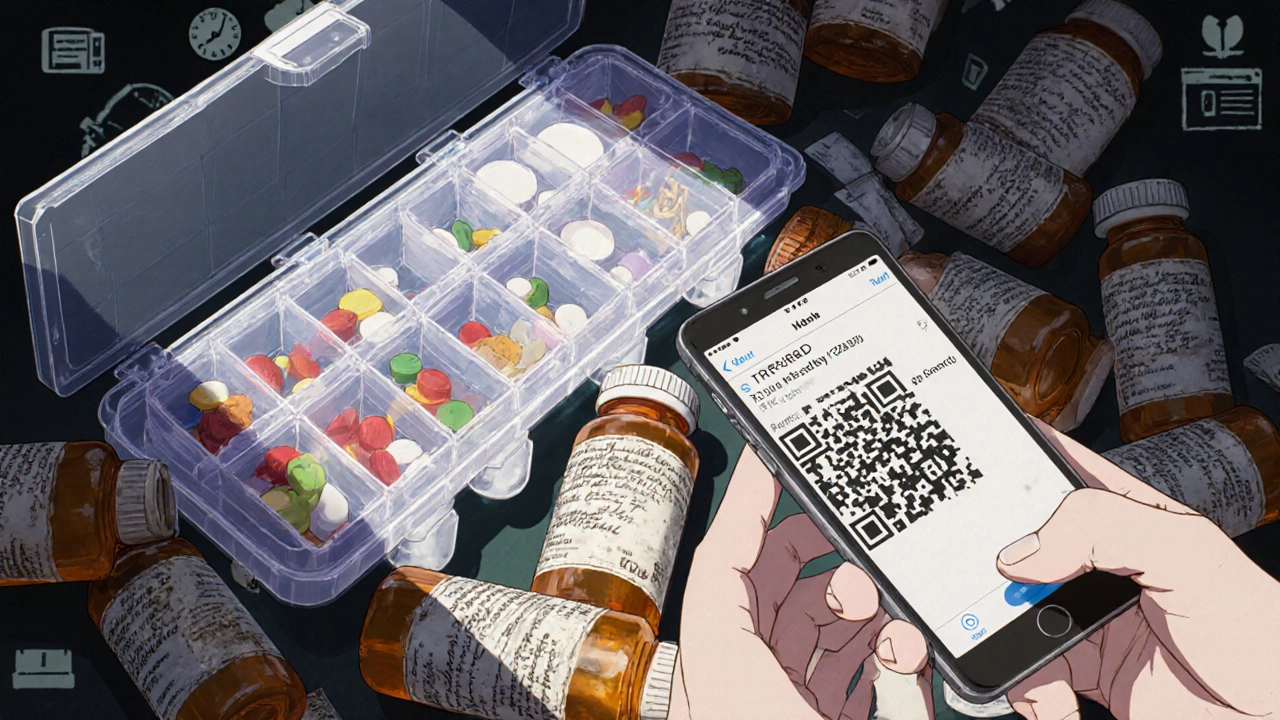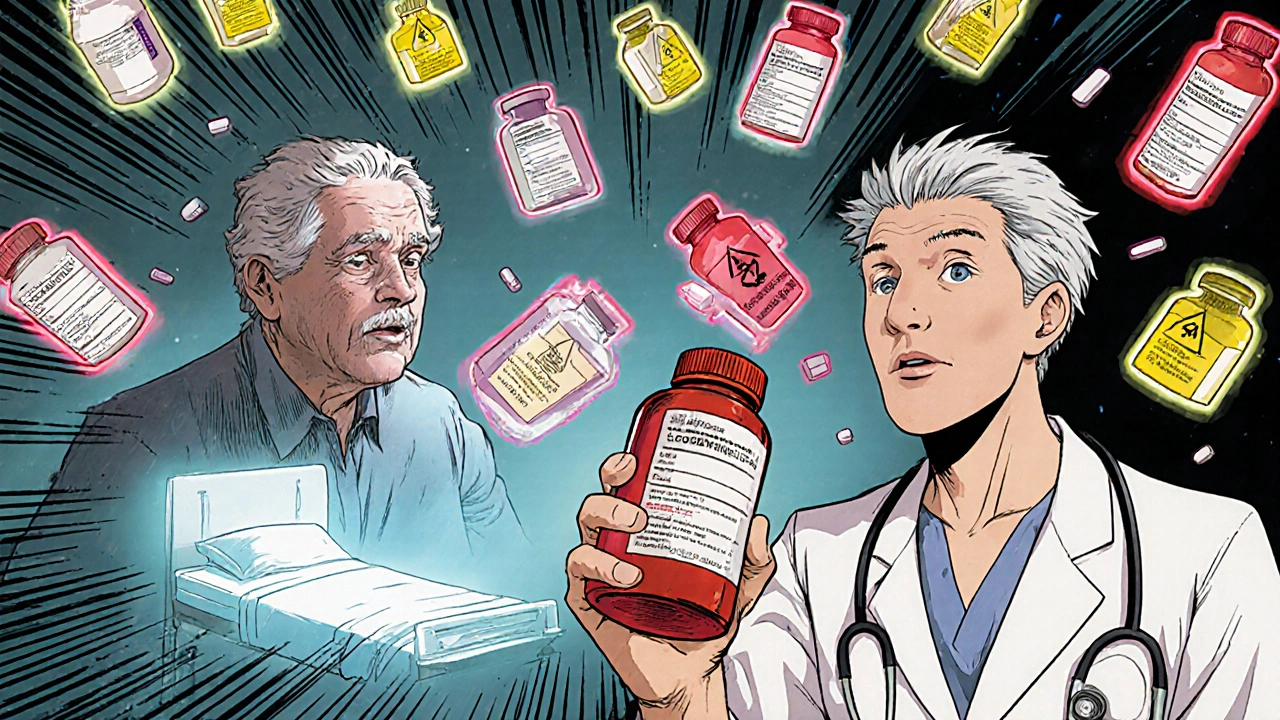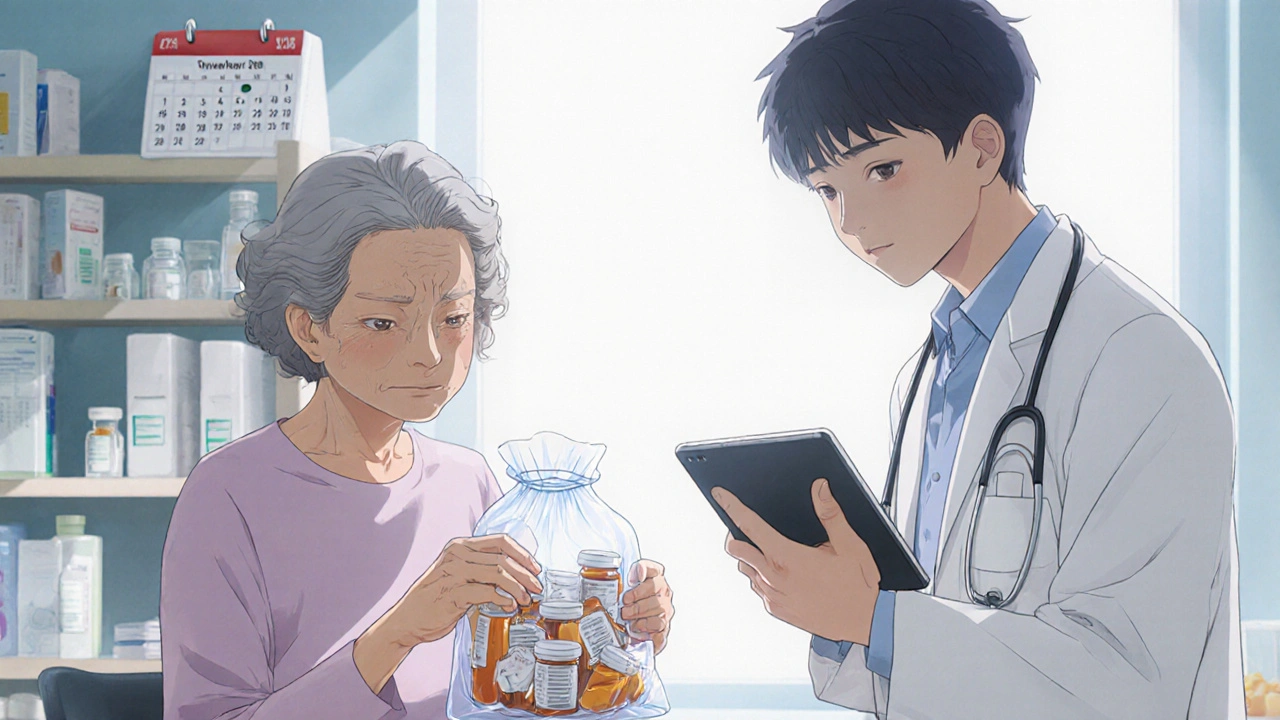Why Bringing Pill Bottles to Your Appointment Matters
It’s not enough to say you take four pills a day. Your doctor needs to know exactly which pills, how much you take, and when you take them. That’s why bringing your actual pill bottles to appointments isn’t just helpful-it’s one of the most effective ways to prevent dangerous medication errors.
Studies show that up to 70% of patients have at least one discrepancy between what they say they take and what they actually take. These gaps cause 18% of primary care visits to involve medication-related problems. Many of these errors happen because people forget names, mix up doses, or stop taking a pill but never told their doctor. The solution? Bring the bottles. The labels have the exact drug name, strength, dosage instructions, and expiration date-no guesswork needed.
What to Bring: Everything, Even the Old Stuff
Don’t pick and choose. Bring every pill, capsule, liquid, patch, or supplement you’ve taken in the last 30 days. That includes:
- Prescription medications (even if you stopped taking them)
- Over-the-counter drugs like ibuprofen, antacids, or sleep aids
- Vitamins, minerals, and herbal supplements (like fish oil, turmeric, or melatonin)
- Any medications in pill organizers, travel cases, or divided containers
Why include expired or discontinued meds? Because your doctor needs to know what you’ve used-and what you might still have lying around. A 2023 study found that 63% of patients throw away empty bottles, making it impossible to confirm if a drug was ever taken. If you tossed the bottle, take a photo of the label before discarding it. Many pharmacists now recommend this as a backup.
The Problem with Pill Organizers
Using a weekly or monthly pill organizer is common, especially for older adults managing multiple medications. But here’s the catch: these organizers hide the real labels. A 2023 study in PMC found that 38% of patients consolidate all their pills into single containers. That means your doctor can’t see the original prescription details-dosage, pharmacy, or prescribing doctor.
When you bring a pill organizer to your appointment, also bring the original bottles. Your provider will compare what’s in the organizer to what’s on the label. If there’s a mismatch-say, you’re taking two 10mg pills but the bottle says 5mg-that’s a red flag. One patient in Perth reported her doctor caught a dangerous interaction between her blood pressure med and a supplement she’d been taking for months, simply because she brought the original bottle.
How to Prepare: A Simple 15-Minute Routine
You don’t need to be a medical expert to get this right. Just follow this simple routine 24 hours before your appointment:
- Gather every medication container you have at home.
- Place them all in a clear plastic bag or small tote-no need to sort them.
- If you use a pill organizer, leave it in place but bring the original bottles too.
- Check for any empty bottles. If you threw them away, pull up your pharmacy app or call your pharmacy to get a list of recent fills.
- Write down any questions: “Why did my doctor stop this?” “Is this still safe with my new heart med?”
Practices that remind patients the day before their appointment see a 47% increase in compliance. If you forget, your provider can still help-but accuracy drops fast without the bottles.

What Happens When You Don’t Bring Them
Skipping this step leads to real risks. A 2024 report from the American Academy of Family Physicians showed that medication errors due to incomplete lists cause 5% of all hospital admissions. That’s not rare. That’s common.
Here’s what typically goes wrong:
- You say you take “that blood pressure pill,” but you stopped it six months ago. Your doctor adds it back in-risking low blood pressure or dizziness.
- You forget you take aspirin daily. Your doctor prescribes a new NSAID, and you end up with stomach bleeding.
- You’re taking a supplement that interacts with your antidepressant. Neither you nor your doctor knows until it’s too late.
One patient in Perth brought her husband’s medications to his appointment after he passed away. She had kept them because she “didn’t know what to do with them.” The doctor discovered she was still taking his blood thinner-and had been for over a year. That kind of mistake can be fatal.
Telehealth and Digital Workarounds: Do They Work?
With telehealth rising, some patients try to show pill bottles on camera. It’s better than nothing, but it’s not enough. A 2024 AMA study found that virtual checks miss 22% of discrepancies, especially around:
- Unused or partially used bottles
- Older pills with faded labels
- Medications stored in unlabeled containers
- Pill organizers that look identical but contain different drugs
Even the best pill-identification apps, like WebMD’s, only get 78% of generic medications right. If you’re on a complex regimen, don’t rely on a photo. Your doctor needs to hold the bottle, read the label, and check the lot number if needed.
Why This Is Especially Important for Older Adults
People over 65 are more likely to take five or more medications. In fact, 47% of older adults in Australia are on polypharmacy regimens. That’s a lot to remember. The American Geriatrics Society says 56% of potentially harmful medications in seniors are only found when the actual bottle is reviewed-not from memory.
That’s why geriatric specialists now require pill bottles at every visit. It’s not about distrust-it’s about safety. One 78-year-old woman in Perth brought her 17 bottles to her appointment. Her doctor noticed she was taking two different versions of the same blood thinner. She didn’t realize they were the same drug. Stopping one cut her risk of bleeding in half.

What Your Doctor Will Do With the Bottles
When you hand over your bag of bottles, your provider won’t just glance at them. They’ll:
- Compare each label to your electronic health record
- Check for duplicates, interactions, or outdated prescriptions
- Confirm dosages match what’s written on the label
- Identify any medications you’ve stopped taking but still have at home
- Update your medication list in real time
Some clinics now use a “brown bag review” system-where you bring everything in one bag. Practices using this method report cutting reconciliation time by 38% and improving accuracy by 67%. It’s fast, simple, and saves lives.
What If You’re Ashamed or Embarrassed?
Many patients feel awkward bringing in old or unused meds. They worry their doctor will judge them. But here’s the truth: your provider has seen it all. A 2023 survey found 28% of non-adherent patients feel ashamed about keeping unused pills. That’s normal. But hiding them is riskier than showing them.
Your doctor isn’t there to scold you. They’re there to keep you safe. If you’re not taking a pill anymore, that’s useful information. If you’re confused about why you’re taking something, that’s a conversation worth having. Many patients report feeling relieved after their doctor explains why a medication was prescribed-or why it’s no longer needed.
Next Steps: Make It a Habit
Don’t wait until you’re sick or in crisis. Make bringing pill bottles part of your routine:
- Set a calendar reminder 24 hours before every appointment.
- Keep a small bag in your car or by the door with extra labels and photos.
- Use apps like Medisafe or MyTherapy to sync your list with pharmacy records.
- Ask your pharmacist for a printed list of all your current prescriptions every time you refill.
- Make medication review part of your annual check-up-most primary care doctors now schedule this.
Medication reconciliation isn’t just a checklist item. It’s a safety net. And the most reliable part of that net? The little plastic bottle with the label you’ve been ignoring.


Author
Mike Clayton
As a pharmaceutical expert, I am passionate about researching and developing new medications to improve people's lives. With my extensive knowledge in the field, I enjoy writing articles and sharing insights on various diseases and their treatments. My goal is to educate the public on the importance of understanding the medications they take and how they can contribute to their overall well-being. I am constantly striving to stay up-to-date with the latest advancements in pharmaceuticals and share that knowledge with others. Through my writing, I hope to bridge the gap between science and the general public, making complex topics more accessible and easy to understand.